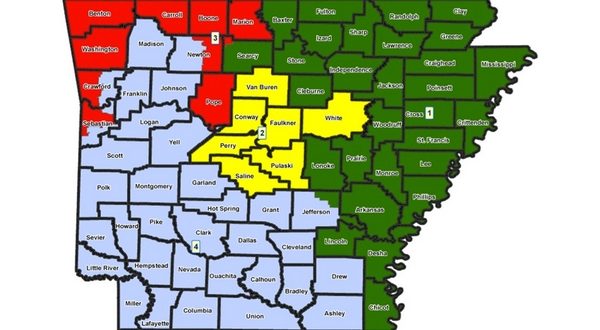
State Rep. Nelda Speaks of Mountain Home is one of several legislators that have filed proposals to redraw Arkansas’ congressional districts.
Speaks, a Republican, filed House Bill 1959 on Sept. 9 and was the first legislator to officially file a redistricting proposal. State legislators are expected to call the General Assembly back into session in the coming weeks to approve a congressional redistricting plan.
Arkansas’ four districts are adjusted by the state legislature every decade to reflect changes in populations. Under law, the state’s four districts must each hold roughly a quarter of the state’s population and cannot vary in population size by more than 1% from one another.
U.S. Census figures indicate that counties in northwest Arkansas and the Little Rock metro area saw the largest spikes in population from 2010 to 2020, while counties in the Delta reported the sharpest population declines.
Speaks says she tried to keep her proposal as close to the existing district map as the rise and fall in the state’s population would allow.
Listen:
Presently, the state’s 1st District includes Baxter, Stone, Izard and Fulton counties. The district begins in Searcy County and extends east to the Missouri boot heel before turning south and running the length of the state to the Louisiana border. Republican Rick Crawford of Jonesboro is the district’s current representative.
The 2nd District consists of seven counties in central Arkansas, with Pulaski County being the largest. Its current representative is Republican French Hill of Little Rock.
The state’s 3rd District covers the northwest corner of the state and extends eastward to include Boone and Marion counties as well as portions of Newton and Searcy counties. It then continues south to Pope County. Republican Steve Womack of Rogers is the district’s current representative.
The 4th District includes the southwestern portion of the state and extends as far north as Madison County. Its current representative is Republican Bruce Westerman of Hot Springs.
Under the redistricting proposal filed by Speaks, the 1st District would add Boone and Marion counties, which are currently a part of the 1st District. The reconfigured 1st District would also add the northwest corner of Searcy County, which is also currently a part of the 1st District. This would make all of Searcy County a part of the 1st District.
The 1st District would also lose Lincoln County in southeast Arkansas and the northeast corner of Jefferson County it currently has.
The 2nd District would lose Van Buren County to the 3rd District but would otherwise remain unchanged.
The 3rd District, which has seen some of the largest population growth in the state over the past 10 years, would cede Boone and Marion counties to the 1st District. It would also lose Pope County and the sections of Newton and Searcy counties it currently has in its district.
To help offset those losses, the 3rd district would gain all of Crawford and Sebastian counties. Those counties are currently split between the 3rd and 4th districts.
The 4th District would add Lincoln, Pope and Van Buren counties. It would also gain the northeast portion of Jefferson County currently held by the 1st District and the portion of Newton County held by the 3rd District. Those additions would place all of Jefferson and Newton counties inside the 4th District.
At least two other legislators, Republican Sen. Mark Johnson of Ferndale and Republican Rep. Jack Ladyman of Jonesboro, have filed their own redistricting proposals.
Notable regional changes in Johnson’s proposal include moving White County into the 1st District and adding Crawford, Franklin, Johnson, Madison, Marion, Newton and Searcy counties to the 3rd district.
One notable regional changes in Ladyman’s proposal includes moving part of White County into the 1st District. Ladyman’s proposed 3rd District would be Benton, Washington, Boone and Carroll counties, as well as parts of Sebastian, Searcy and Crawford counties.
WebReadyTM Powered by WireReady® NSI










